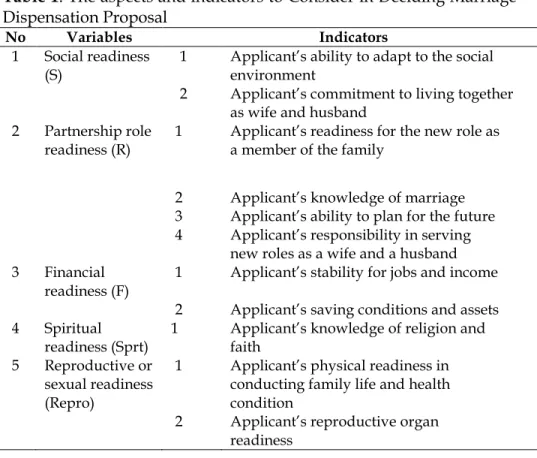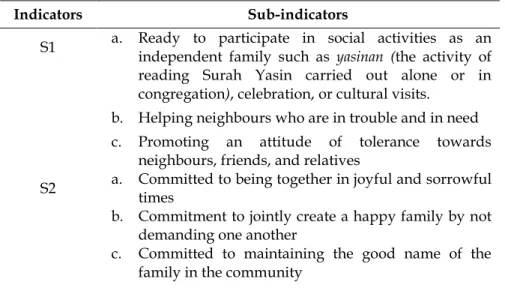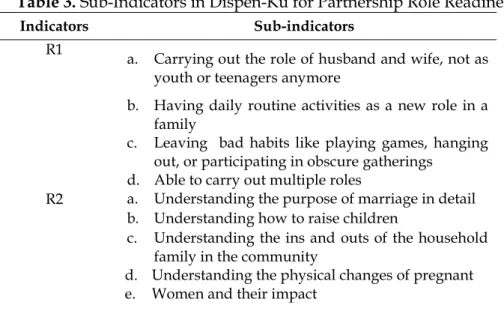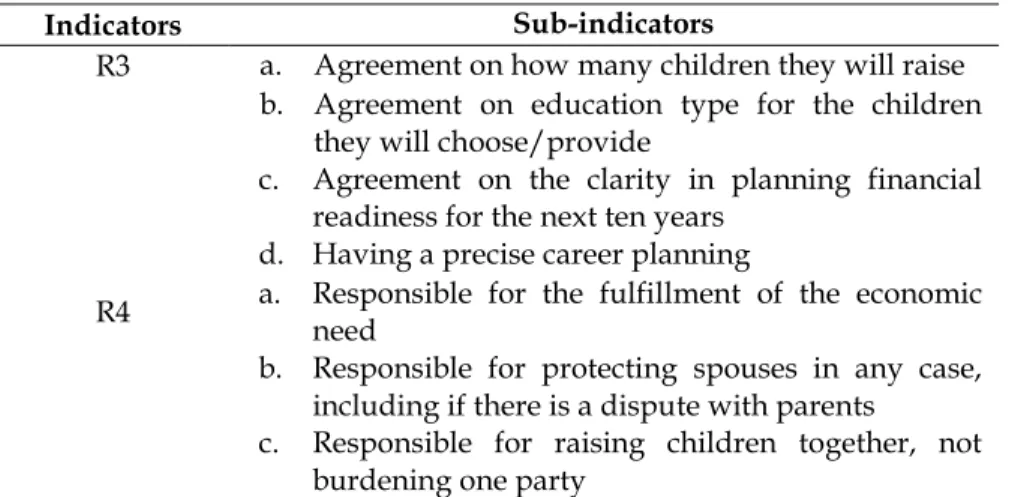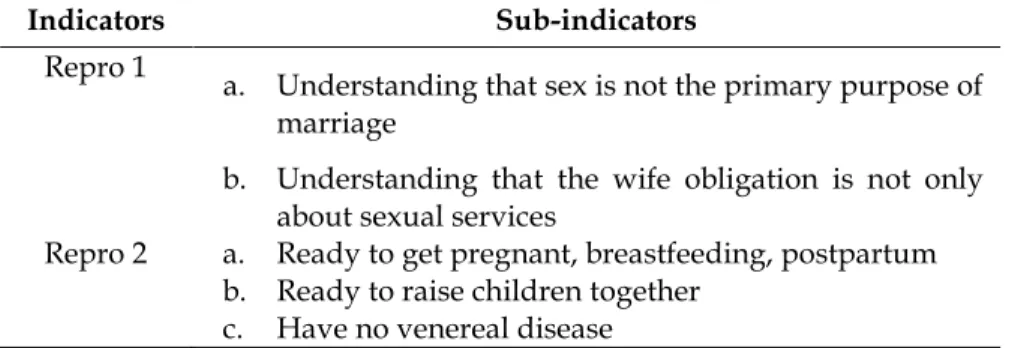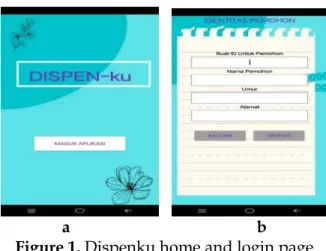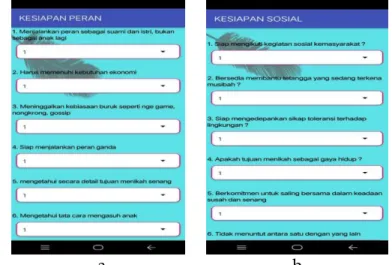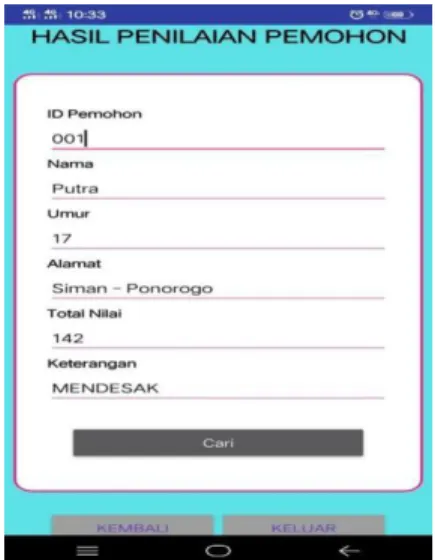Author correspondence email: [email protected]
Available online at: http://ejournal.iainmadura.ac.id/index.php/alihkam/
Copyright (c) 2023 by Al-Ihkam, Jurnal Hukum dan Pranata Sosial
Dispen-ku Android-Based Application:
Assisting Religious Court Judges in Deciding for Marriage Dispensation
Erfaniah Zuhriah
Islamic State University Maulana Malik Ibrahim Malang email: [email protected]
Lutfiana Dwi Mayasari Islamic State Institute of Ponorogo email: [email protected]
Erik Sabti Rahmawati
Islamic State University Maulana Malik Ibrahim Malang email: [email protected]
Abdul Qayuum Bin Abdul Razak Universiti Teknologi MARA Melaka
email: [email protected] Imam Sukadi
Islamic State University Maulana Malik Ibrahim Malang email: [email protected]
Article history: Received: May 06, 2023, Accepted: August 09, 2023, Published:
December 30, 2023
Abstract:
The high rate of child marriage in Indonesia following the marriage dispensation procedure demands an application to help judges decide the proposals accurately and effectively. This 4D development model research aims to create a standard reference in making decisions regarding the dispensation of marriage proposals using an application. The first stage is
defining variables used at the application as measurement, the second stage is designing, namely the process of preparing a conceptual framework in the form of technological innovation, the third stage is developing technological innovation and the fourth stage is disseminating, namely the use of an application.
At the defining stage, the variables to measure the level of urgency in granting the marriage dispensation includes Social, Partnership Role, Financial, Spiritual, and Reproductive or Sexual Readiness. At the designing stage, the Dispen-Ku application is created using Kodular, a website that provides tools for creating Android applications using block programming. In the disseminating stage, the Dispen-ku application which has been uploaded to the Playstore page is distributed to research subjects, namely two judges in Religious Courts.
Keywords:
Marriage Dispensation; Religious Courts; Dispen-ku Application
Introduction
According to the Ministry of Women’s Empowerment and Child Protection of the Republic of Indonesia press release, Indonesia has the highest child marriage rate. It is in the 7th rank globally and 2nd rank in ASEAN.1 It impacts the Human Development Index (HDI) and Poverty Depth Index. Additionally, a report from the Directorate General of the Supreme Court of the Republic of Indonesia's Religious Courts mentions that thousands of requests for marriage dispensation were received and given court decisions. There were 50,747 cases of marriage dispensation in 2022.2 The government has taken several strategic and practical steps to reduce the child marriage rate as it has many negative impacts. One of them is regulating the age limit for marriage, which is 19 years for men and
1https://www.kemenpppa.go.id/index.php/page/read/29/1964/strategi- pencegahan-perkawinan-anak-dirumuskan
2https://goodstats.id/article/pernikahan-dini-masih-marak-terjadi-tahun- 2022-capai-50000-kasus-QdDmx
al-Ihkam: Jurnal Hukum dan Pranata Sosial, 18 (2), 2023: 519-543 521 women.3 Through Law No. 16 of 2019 concerning marriage, the amendment to Law No. 1 of 1974 shows the government’s seriousness in suppressing the number of child marriages.4
In a narrower level, awareness of the village government about the negative impact of child marriage is also starting to appear in various regions.5 The governments in several districts in Madura are actively socializing the age limit for marriage through village activities.6 Rembang has also taken steps to coordinate PUSPAGA (The Center of Family Education) in preventing child marriage.7 In Pamekasan, the government collaborates with Islamic boarding schools to add one year of learning to learn the book on family or household.8 In Ponorogo, the Regent has instructed the village government to draw up a village regulation preventing child marriage.9
However, some researchers and stakeholders ignored another option for marriage for those under the age. This issue then develops when they face phenomena such as marriage dispensation regulation
3 Undang-Undang Nomor 16 Tahun 2019
4 Imam Subchi et al., “Legal Policy of Child Marriage In the Covid-19 Pandemic Period,” Samarah: Jurnal Hukum Keluarga Dan Hukum Islam 5, no. 2 (December 26, 2021): 846–66, https://doi.org/10.22373/sjhk.v5i2.10570.
5 Agoes Dariyo and Raja Oloan Tumanggor, “The Role of Village Apparatus to Prevent Early Marriage in Indonesia,” PALASTREN: Jurnal Studi Gender 15, no. 1 (July 20, 2022): 1–24, https://doi.org/10.21043/palastren.v15i1.11449.
6 Raudlatun Raudlatun and Khairul Asiah, “Peran Pemerintah Desa dalam Upaya Mencegah Pernikahan Anak di Masyarakat Madura,” Khazanah Multidisiplin 1, no. 2 (November 30, 2020): 98–107, https://doi.org/10.15575/km.v1i2.10314.
7 Setiadi Setiadi, “Getting Married Is a Simple Matter: Early Marriage among Indonesian Muslim Girls in Rural Areas of Java,” JSW (Jurnal Sosiologi Walisongo) 5, no. 2 (October 31, 2021): 143–54, https://doi.org/10.21580/jsw.2021.5.2.7970.
8 Nikmah Suryandari and Irya Nur Holifah, “Family Communication as a Prevention Effort Early Marriage in Pegantenan Village, Madura,” Nyimak: Journal of
Communication 6, no. 1 (March 13, 2022): 41–54,
https://doi.org/10.31000/nyimak.v5i2.5069. and Yudho Bawono, Dewi Retno Suminar, and Wiwin Hendriani, “Low Education and Early Marriage in Madura: A Literature Review,” The Journal of Educational Development 7, no. 3 (December 16, 2019): 166–72, https://doi.org/10.15294/jed.v7i1.29283.
9 Muji Setiyo, Proceedings of the 3rd Borobudur International Symposium on Humanities and Social Science 2021 (BIS-HSS 2021) (Springer Nature, 2023). And Hery Ernawati et al., “Health, Psychology and Economic Status: Impact of Early Marriage,”
Open Access Macedonian Journal of Medical Sciences (OAMJMS) 10, no. E (2022): 1364–68.
in Religious Courts. Suppose one or both of the bride and groom do not meet the age limit requirements. In that case, they still have the opportunity to marry at childhood time by applying for a marriage dispensation.10 The loosening of the rules in the form of a marriage dispensation scheme contradicts the efforts of the government to reduce the number of child marriages. This is proved by the surge in requests for dispensation for marriage at the Religious Courts after the increase in the minimum age for marriage.11
One of them is in Ponorogo. The request for marriage dispensation in Ponorogo Religious Court has experienced a significant increase. A total of 165 young couples applied for a marriage dispensation in 2020. It was almost doubled compared to the previous year which was 78 couples.12 Then, in 2021, the number of marriage dispensation requests increased to 90% becoming 296 couples. According to Bappenas (The National Development Planning Agency), there were 13,783 requests for dispensation in the Religious Courts and 190 cases in general courts in 2019. The fulfillment of the request for dispensation of marriage reached 99% of cases.13 The judge's belief that marriage is a "good" goal and should not be impeded becomes the rationale behind granting a marriage dispensation request.14 The judge has given little thought to issues pertaining to women's willingness to carry their reproductive organs, children's rights, mental and financial preparedness, and reproductive health.15
10 “Pro and Cons Contestation on the Increase of Marriage Age in Indonesia | Supraptiningsih | Samarah: Jurnal Hukum Keluarga dan Hukum Islam,” accessed April 8, 2023, https://jurnal.ar-raniry.ac.id/index.php/samarah/article/view/9136.
11 Wakil Ketua Pengadilan Tinggi Agama Surabaya, Busra
12 Accessed from Badilag about cases in religious court.
13https://www.unicef.org/indonesia/media/2856/file/National-Strategy- Child-Marriage-2020.pdf
14 Andi Hidayat Anugrah Ilahi, “The Evaluation of Early Marriage Law Renewal in Indonesia,” Unnes Law Journal 7, no. 1 (April 30, 2021): 129–52, https://doi.org/10.15294/ulj.v7i1.43000.
15 Fatum Abubakar, “Islamic Family Law Reform: Early Marriage and Criminalization (A Comparative Study of Legal Law in Indonesia and Pakistan),” Al- Ahkam Jurnal Ilmu Syari’ah Dan Hukum 4, no. 2 (December 31, 2019), https://doi.org/10.22515/alahkam.v4i2.1667.
al-Ihkam: Jurnal Hukum dan Pranata Sosial, 18 (2), 2023: 519-543 523 It won't be ideal to launch a huge effort to stop child marriage if the offenders can get away with it because of a legal loophole. It forbids but leaves up the possibility of authorization. Therefore, a standard reference is needed for judges of the Religious Courts in making decisions regarding the dispensation of marriage. The required variables that assess the two young couples' situations, parenting styles, supportive economic conditions, and reproductive health are the standard references included in the proposed application. These variables are hoped to open the insight and become considerations of judges of the Religious Courts in considering the request for marriage dispensation so that the reason for granting is not limited to the "good faith" clause religiously.16 The dispensation applicant's social, psychological, and economic circumstances must also be the judge’s consideration because the problems faced by child marriage couples will be more prone and severe, such as domestic violence, economic problems, and so on.17
Studies discussing marriage dispensation conducted by many experts still need more development. From a law perspective, Supraptiningsih discusses the opportunities to accept requests for marriage dispensations based on Perma No. 5 of 2019. According to this research, marriage dispensation is the alternative step taken by people who agree with child marriage.18 Taufiqurrahman, meanwhile, argues that the interpretation of ‘urgent reasons’ in marriage dispensation should prioritize the best interests of future couples rather than merely considering potential violations of religious and social norms.19 Regarding Islamic law, Efrinaldi states that regulation of marriage dispensation potentially brings al-mashlahat in certain
16 Koalisi 18+. (2016). Menyingkap Tabir Dispensasi Perkawinan. (Jakarta:
Indonesia)
17 Jason S. Carroll et al., “Ready or Not?: Criteria for Marriage Readiness Among Emerging Adults,” Journal of Adolescent Research 24, no. 3 (May 1, 2009): 349–
75, https://doi.org/10.1177/0743558409334253.
18 Umi Supraptiningsih, “Pro and Cons Contestation on The Increase of Marriage Age in Indonesia,” Samarah: Jurnal Hukum Keluarga Dan Hukum Islam 5, no. 1 (June 30, 2021): 231–51, https://doi.org/10.22373/sjhk.v5i1.9136.
19 Taufiqur Rohman et al., “Preventing Violations of Religious and Social Norms: Judicial Interpretation of ‘Urgent Reasons’ in Marriage Dispensation at the Wonosari Religious Court, Indonesia,” JIL: Journal of Islamic Law 4, no. 2 (August 30, 2023): 218–36, https://doi.org/10.24260/jil.v4i2.1535.
circumstances. However, to reach that maslahah, standardization in the process of adjudicating marriage dispensation in court as well as guidelines for judges to be serious and careful in examining marriage dispensation cases are required to fulfill a sense of justice for justice seekers.20
Based on those facts, we want to provide the variables needed to measure the readiness of couples who apply for marriage dispensation by using Android-based application. Made easy to use, it is wished to help judges in deciding the dispensation marriage proposal effectively and efficiently. Therefore, this research aims to create an android-based application namely APK (Decision Support Analysis) called Dispen-Ku which can help judges make the right decision on marriage dispensation proposals. It is hoped that it can be one of the judges' considerations in measuring the importance and need for either granting or rejecting a marriage dispensation request.
To achieve that purpose, this research wants to describe the process of defining, designing, developing, and disseminating the Dispenku Application.
Method
This study uses a 4D development model research. The first stage is the defining step. In this stage, we conduct a need analysis process. This stage was carried out by conducting FGDs and interviews with 3 judges, 5 heads of KUA (Religious Affairs Office), 4 legal practitioners, and 2 religious experts. The second stage is the designing step, namely the process of preparing a conceptual framework in the form of technological innovation. The third stage in this research is the developing step which develops the technological innovation involving validation tests in the form of an Android-based application called "Sispenku". The fourth stage is the disseminating step, namely the use of the "Dispenku" application to the research subjects, namely judges in the Religious Courts. The data collection
20 Efrinaldi Efrinaldi, Jayusman Jayusman, and M. Yenis, “Revealing The Dilemma Of Marriage Dispensation Regulations In Indonesia,” ADHKI: Journal of Islamic Family Law 5, no. 1 (July 24, 2023): 31–46, https://doi.org/10.37876/adhki.v5i1.113.
al-Ihkam: Jurnal Hukum dan Pranata Sosial, 18 (2), 2023: 519-543 525 method in this study used two ways: Focus Group Discussion (FGD)21 and interview. The results of interviews and FGD was classified based on the compiled variables while the classification was displayed in the form of table. The next process was the coding process for making an Android-based application system. The coding system in this study coincided with the interpretation of the data to produce the information needed in this study.
Result and Discussion
Defining Process: A Need Analysis in Enlisting Variable to Measure the Urgency Level of Marriage Dispensation
In the FGD with the judges, it was agreed that the arrangement of variables would be more relevant if it were carried out with the wedding officiants. It is because they had direct contact with the dispensation applicants.22 The FGD with the wedding officiant was carried out in two sessions at once because some considerations were included in the variables. These considerations include debates regarding responsibility and mutual blame between FGD members so that discussions cannot run well. During the FGD, we found there were five variables to consider as the main things to help judges in deciding dispensation marriage. Those variables consist of social readiness, partnership role, financial, spiritual, and reproductive or sexual readiness. Marriage readiness is defined as the way individuals view themselves in carrying out the functions and roles of marriage.23
In this academic forum, judges, heads of KUA, legal practitioners, and religious experts broke the aspects into some variables that will operationally lead the decision of the judges in the application. The variables can be seen in Table 1.
21 FGD was conducted involving 15 people ranging from judges, head of KUA, religious figures, advocate, to academicians.
22 Eva Meizara Puspita Dewi, Widyastuti Widyastuti, and Novita Maulidya Djalal, “Relationship of Marriage Perception and Married Readiness in Women’s Adolescents in Makassar City,” Journal of Humanities and Social Science (IOSR-JHSS) 25, no. 1 (January 2019): 74–78.
23 Nur Syifa Ramdani, Tin Herawati, and Musthofa, “The Effect of Religiosity and Social Support on Marriage Readiness in the Young Adult Age Group,” Journal of Child, Family, and Consumer Studies 2, no. 3 (December 21, 2023): 271, https://doi.org/10.29244/jcfcs.2.3.270-280.
Table 1. The aspects and indicators to Consider in Deciding Marriage Dispensation Proposal
No Variables Indicators
1 Social readiness
(S) 1 Applicant’s ability to adapt to the social environment
2 Applicant’s commitment to living together as wife and husband
2 Partnership role readiness (R)
1 Applicant’s readiness for the new role as a member of the family
2 Applicant’s knowledge of marriage 3 Applicant’s ability to plan for the future 4 Applicant’s responsibility in serving
new roles as a wife and a husband 3 Financial
readiness (F)
1 Applicant’s stability for jobs and income 2 Applicant’s saving conditions and assets 4 Spiritual
readiness (Sprt)
1 Applicant’s knowledge of religion and faith
5 Reproductive or sexual readiness (Repro)
1 Applicant’s physical readiness in conducting family life and health condition
2 Applicant’s reproductive organ readiness
It can be seen from Table 1 that there are five variables with some indicators in every variable. Only the variable “Spiritual Readiness” contributes one indicator. During this research, we and the member of FGD tried to detail the indicators and generate the sub- indicators. To detail this, we code every indicator as presented in Table 1. Every variable, actually, was generated based on the real situation which is mostly faced by the judges. By detailing these variables into sub-indicators, it will be helpful to design a precise measurement at the Dispenku.
Social Readiness Variables
After marriage, the couple will live along with the community in the new social environment. In addition, couples who are getting married will also interact with the spouse’s extended family, friends
al-Ihkam: Jurnal Hukum dan Pranata Sosial, 18 (2), 2023: 519-543 527 of the spouse to new organizations or affiliations to follow. Social readiness becomes a critical point to measure before entering the marriage life.24 Social readiness variables that will be included in the Dispen-Ku application include some sub-indicators which can be seen in Table 2.
Table 2. Sub-indicators in Dispen-Ku for Social Readiness
Indicators Sub-indicators
S1 a. Ready to participate in social activities as an independent family such as yasinan (the activity of reading Surah Yasin carried out alone or in congregation), celebration, or cultural visits.
b. Helping neighbours who are in trouble and in need c. Promoting an attitude of tolerance towards
neighbours, friends, and relatives
S2 a. Committed to being together in joyful and sorrowful times
b. Commitment to jointly create a happy family by not demanding one another
c. Committed to maintaining the good name of the family in the community
It can be seen from Table 2 that the sub-indicators can be used to measure applicants’ readiness for social life. The judge will ask each variable and then score the result according to the applicants’
answers. The higher the number, the more urgent their request for marriage dispensation to be approved. On the other hand, the lower the number, the less urgent the request is to be granted. The results of these variable’s accumulation are compiled based on Law No. 16 of 2019. The law explains that the only reason for applying for a marriage dispensation is "urgent reasons" so the category of urgency
24 Danik Nur Fitria Ningrum, Melly Latifah, and Diah Krisnatuti, “Marital Readiness: Exploring the Key Factors among University Students,” HUMANITAS:
Indonesian Psychological Journal 18, no. 1 (February 27, 2021): 65, https://doi.org/10.26555/humanitas.v18i1.17912.
at the recent application is made as a measurement to either grant or reject the request.
Partnership Role Readiness Variables
After marriage, someone will take on a new role. They are no longer a pair of teenagers who are free to do whatever they want. The new role in a household may differ from what was imagined so far.
Indonesian traditional families whose wives are in charge of household chores increasingly give them more pressure when women work in public sector, they still have to do domestic work when they are at home.25
The readiness of partnership roles that will be included in the Dispen-Ku application contain sub-indicators written in Table 3.
Table 3. Sub-Indicators in Dispen-Ku for Partnership Role Readiness
Indicators Sub-indicators
R1 a. Carrying out the role of husband and wife, not as youth or teenagers anymore
b. Having daily routine activities as a new role in a family
c. Leaving bad habits like playing games, hanging out, or participating in obscure gatherings
d. Able to carry out multiple roles
R2 a. Understanding the purpose of marriage in detail b. Understanding how to raise children
c. Understanding the ins and outs of the household family in the community
d. Understanding the physical changes of pregnant e. Women and their impact
25Siti Mas’udah, “Familial Relationships and Efforts in Retention of Marriage among Atomistic Families in Indonesia,” Cogent Social Sciences 8, no. 1 (December 31, 2022): 2046313, https://doi.org/10.1080/23311886.2022.2046313.
al-Ihkam: Jurnal Hukum dan Pranata Sosial, 18 (2), 2023: 519-543 529
Indicators Sub-indicators
R3 a. Agreement on how many children they will raise b. Agreement on education type for the children
they will choose/provide
c. Agreement on the clarity in planning financial readiness for the next ten years
d. Having a precise career planning
R4 a. Responsible for the fulfillment of the economic need
b. Responsible for protecting spouses in any case, including if there is a dispute with parents
c. Responsible for raising children together, not burdening one party
Table 3 with the whole enlisted sub-indicators shows that marriage may also become a stressful transition.26 In contrast to friendship, marriage is (almost always) a presumptively permanent relationship. It is formed on the basis of mutual commitment between, typically, two people.27 Each partner will understand their rights and obligations as husband, wife, parent, and child if they grasp their various roles. They all need to carefully come to terms with the fact that they naturally assume two roles after marriage. They can arrange themselves in accordance with the role they are performing if they comprehend it.28
Financial Readiness Variables
A happy and well-functioning family is shown not only by outward appearances but also by rational thinking in a familial partnership. Prior to marriage, one should think about future essential necessities, such as the expense of raising children in order to ensure a pleasant household life. In Indonesia, successful marriages nowadays are based on three fundamental principles: faith, family, and
26 Laura K. Soulsby and Kate M. Bennett. "When Two Become One: Exploring Identity in Marriage ND Cohabitation." Journal of Family Issues 38.3 (2017): 358-380, https://journals.sagepub.com/doi/full/10.1177/0192513X15598547.
27 Elizabeth Brake, After Marriage: Rethinking Marital Relationships (Oxford:
Oxford University Press, 2016), 16.
28 Dunn, 99.
finances.29 The financial readiness in the Dispen-Ku application includes, as expressed in sub-indicators, some criteria as can be seen in Table 4.
Table 4. Sub-indicators in Dispen-Ku for Financial Readiness
Indicators Sub-indicators
F1 a. Having a fixed income of at least the UMR (The Regional Minimum Wage) of the city where they live b. Understanding financial management
c. Not economically relying on parents F2 a. Having a minimum savings of UMR
b. Not only relying on inheritance
Table 4 shows that financial readiness is very influential on marital satisfaction in the long term since it can affect economic stability for the physical and mental sustainability of family members.30 Sufficient family financial conditions provide a sense of security in financial support.31 This means that individuals who have a good family income will be more ready to get married because of financial support.32
Spiritual Readiness variables
The basis of religion is the most crucial basis when someone gets married. A good understanding of religion will also positively impact domestic life. Islamic family law cannot be separated from the history of the legal system in Indonesia from
“When Two Become One: Exploring Identity in Marriage and Cohabitation - Laura K. Soulsby, Kate M. Bennett, 2017.”
29 Pam Nilan, “Youth Transitions to Urban, Middle-Class Marriage in Indonesia: Faith, Family and Finances,” Journal of Youth Studies 11, no. 1 (February 2008): 65–82, https://doi.org/10.1080/13676260701690402.
30 Fitri Sari and Euis Sunarti, “Kesiapan Menikah pada Dewasa Muda dan Pengaruhnya Terhadap Usia Menikah,” Jurnal Ilmu Keluarga dan Konsumen 6, no. 3 (September 2013): 150, https://doi.org/10.24156/jikk.2013.6.3.143.
31 Ramdani, Herawati, and Musthofa, “The Effect of Religiosity and Social Support on Marriage Readiness in the Young Adult Age Group,” 278.
32 Ramdani, Herawati, and Musthofa, 278.
al-Ihkam: Jurnal Hukum dan Pranata Sosial, 18 (2), 2023: 519-543 531 the time of Dutch colonialism to the present which involves three com ponents namely the interests of religion, the state, and women.33
The spiritual readiness in the Dispen-Ku application follows the sub-indicators as stated in Table 5.
Table 5. Sub-Indicators in Dispen-Ku for Spiritual Readiness
Indicators Sub-indicators
Sprt
a. Understanding that marriage is not only for the ability to have sexual activities
b. Understanding the concept of rape in marriage c. Understanding the concept of protection in the
family
d. Ability to recite the Qur’an
It can be seen from Table 5 that those who are deemed more religious will also be more ready to get married.34 The role of religion in preparing for marriage is an important factor.35 Fitriani and Handayani explain that there is a significant positive relationship between religiosity and readiness to get married.36 Meanwhile, Keldal states that a high level of religiosity is strongly related to a great belief in the meaning of marriage and affects financial, emotional, and interpersonal relationship readiness.37
33 Taufik Hidayat Simatupang, “Adult Age in Marriage in Indonesia (Theoretical Study of the Application of the Lex Posterior Derogat Legi Priori Principle),” Jurnal Penelitian Hukum De Jure 21, no. 2 (June 24, 2021): 213, https://doi.org/10.30641/dejure.2021.V21.213-222.
34 Gökay Keldal, “Associations Between Religiosity and Marital Beliefs among Emerging Adults,” Türk Psikolojik Danışma ve Rehberlik Dergisi 12, no. 65 (July 1, 2022):
257, https://doi.org/10.17066/tpdrd.1138281.
35 Ramdani, Herawati, and Musthofa, “The Effect of Religiosity and Social Support on Marriage Readiness in the Young Adult Age Group,” 271.
36 Dita Anisa Fitriani and Agustin Handayani, “Hubungan Antara Kematangan Emosi dan Religiusitas dengan Kesiapan Menikah pada Mahasiswa Fakultas Psikologi Universitas Islam Sultan Agung Semarang,” Prosiding Konstelasi Ilmiah Mahasiswa Unissula (KIMU) Klaster Humanoira, no. 0 (December 17, 2021): 289, https://jurnal.unissula.ac.id/index.php/kimuhum/article/view/8140.
37 Keldal, “Associations Between Religiosity and Marital Beliefs among Emerging Adults,” 251.
Reproductive or Sexual Readiness Variables
Reproduction can be interpreted as the process of human life in producing offspring. Because the definition is too general, reproduction is often only considered a sexual or intimate relationship. Lack of education on matters related to reproduction can lead to unwanted things. Therefore, married couples must also get reproductive readiness before entering the marriage stage. The reproductive or sexual in the Dispen-Ku application contains sub- indicators represented in Table 6.
Table 6. Sub-Indicators in Dispen-Ku for Reproductive Readiness
Indicators Sub-indicators
Repro 1
a. Understanding that sex is not the primary purpose of marriage
b. Understanding that the wife obligation is not only about sexual services
Repro 2 a. Ready to get pregnant, breastfeeding, postpartum b. Ready to raise children together
c. Have no venereal disease
As clear in Table 6, marriage should not be deemed as a way to fulfill sexual needs only. Unfortunately, because religions, particularly Islam, forbid adultery, young people with higher levels of religiosity expect to marry at an earlier age in order to avoid adultery.38 In fact, there are sufficient provisions needed to build a household, both morally and materially. Sexual relationship is only a small part of it, yet ignorance of reproductive health will lead to disharmony in the household.39 Therefore, it is hoped that domestic life will be in accordance with everyone’s dream, namely a happy household.40
38 Keldal, 256.
39 Riantini Amalia and Pulung Siswantara, “Efektivitas Penyuluhan Kesehatan Reproduksi pada Calon Pengantin di Puskesmas Pucang Sewu Surabaya,” Jurnal Biometrika dan Kependudukan 7, no. 1 (December 10, 2018): 29, https://doi.org/10.20473/jbk.v7i1.2018.29-38.
40 Kartika Adyani, Catur Leny Wulandari, and Erika Varahika Isnaningsih,
“Faktor–Faktor yang Mempengaruhi Pengetahuan Calon Pengantin dalam Kesiapan Menikah,” Jurnal Health Sains 4, no. 1 (January 18, 2023): 110, https://doi.org/10.46799/jhs.v4i1.787.
al-Ihkam: Jurnal Hukum dan Pranata Sosial, 18 (2), 2023: 519-543 533 The above indicators result from the source persons through focus group discussion and interview. Those indicators can be used by judges when dealing with requests for marriage dispensation as main consideration in deciding a marriage dispensation proposal.
Designing Process: The Dispen-Ku Preliminary Design in a Marriage Dispensation Application
The result of need analysis in the form of sub-indicators was used in designing the main application. In this step, we used them as main items in determining whether the dispensation marriage proposal can be accepted or not by giving a score for every sub- indicator. The scores are respectively 1 to 3 which range from low reasons for score 1, medium for score 2, and urgent for score 3. After all, the total score for all sub-indicators is clustered into three categories. Those are not urgent to grant, urgent to grant, and very urgent to grant the marriage dispensation. This criterion is then actualized into the application-maker or software.
Dispen-Ku application is made using Kodular.41 Kodular is a website that provides tools for creating Android applications using block programming. This application was designed one month after the FGD and interview process. In other words, application makers do not need to make programming code to create Android applications manually. Kodular provides superior features, namely the Kodular Store and the Kodular Extension IDE, making it easier for developers to upload Android applications to the Kodular Store and make blocks of IDE extension programs according to the developer’s wish.42
In this initial research stage, the Dispen-Ku application was used by judges who were FGD participants in this study. Dispen-Ku application was sent directly to the three judges participating in the FGD via email. They download it using their respective cellphones accompanied by a complete guide to using the Dispen-Ku application.
41 Ronaldo, Ronaldo, and Ardoni Ardoni. "Pembuatan Aplikasi Mobile"
Wonderful of Minangkabau" sebagai Gudang Informasi Pariwisata di Sumatera Barat Melalui Website Kodular." Info Bibliotheca: Jurnal Perpustakaan dan Ilmu Informasi 2.1 (2020): 88-94.
42 Y. Y. Welim et al., “Pengembangan Sistem Informasi Service Kendaraan pada Bengkel Kfmp,” vol. 6, no. 1, pp. 17–26, 2015
This sort of trial process took three weeks until the judge provided feedback on the application.
We intentionally did not upload the Dispen-Ku application through the Play Store for security reasons. Given that the Dispen-Ku application is only intended for judges, uploading via the Playstore is deemed to potentially cause data leaks since all parties can download it freely. To prevent this and while preparing the follow-up concept for the Dispen-Ku application, this application has not yet been disseminated.
Developing Process: Making APK (Decision Support Application) Dispen-ku for Judges in Religious Courts
In this step, we directly used the application maker to put the sub-indicators into an Android-based aplication. As a result, the interface of the Dispen-ku application, the front page and login page, can be seen in Figure 1.
a b
Figure 1. Dispenku home and login page
Figure 1 shows that the Dispenku application performs the initial home and login page. The homepage shows that users, in this case the Judges, can operate the application. If they cannot open this page, it shows that their mobile phone is not compatible and cannot use the application. Meanwhile, Figure 1b shows that judges need to submit the identity of applicants. On the second page of the Dispen-Ku application, the judge enters the applicant’s ID. The judge enters the applicant ID as a code to get the final
al-Ihkam: Jurnal Hukum dan Pranata Sosial, 18 (2), 2023: 519-543 535 result. For example, the judge enters code 001. At the end of the Dispen-Ku application page, the judge only needs to enter the code 001 to see the results. There are no patent rules regarding the applicant’s ID because the applicant’s ID is the judge’s authority to distinguish between one applicant and another. Then, the applicant’s name is filled in according to the applicant’s name and so do the age and address forms. When the judge enters the applicant’s ID on the last page, information about the name, age, and address will automatically appear in the system.
The sub-indicators that score the applicants’ readiness are performed in the next pages. The main features of the Dispenku application are clear than in Figure 2 below.
a b
Figure 2. The main features of the Dispenku application
Figure 2 shows that the main features in Dispenku contain sub-indicators that were obtain from the need analysis process. All sub-indicators for the indicators above have been displayed in the Dispenku application. Figure 2a and Figure 2b respectively show the variable of social readiness and partnership role readiness. The other variables are also presented in a similar form as Figure 2, namely in financial, spiritual, and reproductive readiness. It can be seen clearly from Figure 2 that every sub-indicator contains a 1 to 3 score. This score is, then, chosen by the judges as the main consideration for deciding the marriage dispensation request. In the end, the total score
from each sub-indicator is counted and the decision comes up. The result of the total score for deciding the dispensation marriage proposal can be seen in Figure 3.
Figure 3. The final decision from Dispenku
It is clear from Figure 3 that in a try-out case, it is deemed urgent for the judges to grant the dispensation marriage proposal.
That decision was taken because the total score is 142. From the criteria determined by researchers, this number shows that the marriage dispensation proposal must be granted soon. There will be 3 types of information/results that appear in the Dispen-Ku application:
First, not urgent: This is valid if the result is under 100. It means that the request for marriage dispensation is better rejected because the applicant's situation and readiness do not meet the requirements to establish a household.
Second, urgent conditions: This is valid if the result is between 100- 130. It means that the situation and readiness of the applicant are indeed urgent for the dispensation proposal to be granted with the condition that one of the financial components gets 3 points in all indicators.
The last is very urgent: This is valid if the result is up to 130. It means that the situation and readiness of the applicant are more than
al-Ihkam: Jurnal Hukum dan Pranata Sosial, 18 (2), 2023: 519-543 537 adequate so it is very urgent to grant the marriage dispensation requests.
In short, to measure the results of each applicant’s assessment, the judge only needs to enter the applicant’s ID according to the ID entered on the second page of the Dispen-Ku application. Later, the column name in the description will be filled automatically. Because this application is in the form of an APK or Decision Support Application, the final decision maker remains on the judge’s side. In another word, this application is a sort of help or support to ease judges’ considerations before deciding the request for marriage dispensation.
Disseminating Process: Use of the APK Dispen-ku by Judges in Religious Courts
There are two judges who use this application in making decisions on applications for marriage dispensation. One is the Judge of the Lewoleba Religious Court, NTT and another is the Judge of the Tarakan Religious Court, North Kalimantan.
Tarakan Religious Court Judge, North Kalimantan, Nur Triono,43 stated that this application can provide a new perspective in providing several structured legal considerations for judges who will determine requests for marriage dispensation. However, he also provided several suggestions regarding the Dispen-ku application, namely: improving the interface, the need to review the application operation flow map so that its use becomes more efficient, and selection of variables using the "per touch point" method which is believed to be more efficient than the drop list selection model.
According to Nur Triono, determining a dispensation for child marriage is the last stage before the child marriage takes place. There are at least five parties who have direct contact with child marriage, namely: the child, the child's parents, the prospective parents-in-law, and the judge. The higher each parties understands their children's rights, the greater the number of marriage dispensations can be reduced. However, even if this application is only used by judges who will determine requests for marriage dispensation, based on the 5
43 Interview with Nur Triono, Tarakan Kalimantan Utara Religious Court Judge, 1 November 2023
(five) parties, this application, at least, can reduce the number of child marriages by up to 10%.
Meanwhile, Akmal Adi Cahya,44 a judge at the Lewoleba Religious Court gave his views regarding the APK Dispenku. He stated that the obstacle currently experienced by judges is the difficulty of measuring the level of "urgency" to legitimize granting a request for a marriage dispensation. Urgency does not have a definite measure so in the end the majority of cases, marriage dispensation is granted on the pretext that it is for the good of the applicant.
However, he confesses that beyond that, the divorce rate is also increasing because the marriage age is very young.
Above all, the existence of the Dispenku APK is considered to be able to help judges measure the meaning of urgency through the variables prepared in the application. When the judge explores the reasons for applying for a marriage dispensation, the judge can measure the urgency using the application’s features.
Conclusion
The prevalence of child marriage occurs partly because of the high rate of granting requests for marriage dispensation. Therefore, this APK is an alternative to minimize the number of child marriages by tightening marriage dispensation while paying attention to the situation of each applicant. This development research uses a 4D research development model to design a Dispen-ku APK application that can be used by judges as a guide in deciding cases regarding marriage dispensation requests. The making of the APK "Dispen-Ku"
in this study involved judges in recognizing the rights of the youth by considering economic, health, and psychological factors as well as social and spousal roles and spirituality while emphasizing the judge’s commitment to abolish the practice of child marriage which has the potential to bring more comprehensive harm after the dispensation is granted. This research merely involved judges, lawyers, mediators, and religious experts in the Focus Group Discussion participants and informants. Further research is, undoubtedly, required by involving several government institutions,
44 Interview with Akmal Adi Cahya, Lewoleba NTT Islamic Religious Court, 1 November 2023
al-Ihkam: Jurnal Hukum dan Pranata Sosial, 18 (2), 2023: 519-543 539 especially the Supreme Court as one of the sources in which they are positioned as a policy maker regarding court policy.
Acknowledgment
The authors would like to thank for the financial support from the Rutger WPF Indonesia through the Grant Research Power to Youth 2021-2022. The same words were conveyed to all the sources and key informants who were present during the focus group discussion for their willingness to provide information in this research. We also express our gratitude to the editors and reviewers of the Al Ihkam journal for their suggestions and input on this article, from the beginning until this article was successfully published.
Bibliography
Abubakar, Fatum. “Islamic Family Law Reform: Early Marriage and Criminalization (A Comparative Study of Legal Law in Indonesia and Pakistan).” Al-Ahkam Jurnal Ilmu Syari’ah Dan
Hukum 4, no. 2 (December 31, 2019).
https://doi.org/10.22515/alahkam.v4i2.1667.
Adyani, Kartika, Catur Leny Wulandari, and Erika Varahika Isnaningsih. “Faktor – Faktor yang Mempengaruhi Pengetahuan Calon Pengantin dalam Kesiapan Menikah.” Jurnal Health Sains 4, no. 1 (January 18, 2023): 109–19.
https://doi.org/10.46799/jhs.v4i1.787.
Alfitri, Alfitri. "The Role of Sharia Judges in Indonesia: Between the Common Law and the Civil Law Systems." Mazahib 16.2 (2017):
110-124.
Al-Hasan, Fahadil Amin, and Deni Kamaluddin Yusup. "Dispensasi Kawin dalam Sistem Hukum Indonesia: Menjamin Kepentingan Terbaik Anak Melalui Putusan Hakim." Al-Ahwal: Jurnal Hukum Keluarga Islam 14, no. 1 (2021): 86-98.
Amalia, Riantini, and Pulung Siswantara. “Efektivitas Penyuluhan Kesehatan Reproduksi pada Calon Pengantin di Puskesmas Pucang Sewu Surabaya.” Jurnal Biometrika dan Kependudukan 7,
no. 1 (December 10, 2018): 29.
https://doi.org/10.20473/jbk.v7i1.2018.29-38.
Bawono, Yudho, Dewi Retno Suminar, and Wiwin Hendriani. “Low Education and Early Marriage in Madura: A Literature Review.”
The Journal of Educational Development 7, no. 3 (December 16, 2019): 166–72. https://doi.org/10.15294/jed.v7i1.29283.
Bilalu, Naskur, et al. "Compilation of Islamic Law as Judge's Consideration at a Religious Court in North Sulawesi, Indonesia." Samarah: Jurnal Hukum Keluarga dan Hukum Islam 6.2 (2022): 514-536.
Brake, Elizabeth. After Marriage: Rethinking Marital Relationships.
Oxford University Press, 2016.
Carroll, Jason S., Sarah Badger, Brian J. Willoughby, Larry J. Nelson, Stephanie D. Madsen, and Carolyn McNamara Barry. “Ready or Not?: Criteria for Marriage Readiness Among Emerging Adults.” Journal of Adolescent Research 24, no. 3 (May 1, 2009):
349–75. https://doi.org/10.1177/0743558409334253.
Dariyo, Agoes, and Raja Oloan Tumanggor. “The Role of Village Apparatus to Prevent Early Marriage in Indonesia.”
PALASTREN: Jurnal Studi Gender 15, no. 1 (July 20, 2022): 1–24.
https://doi.org/10.21043/palastren.v15i1.11449.
Darmawan, Darmawan, et al. "Marriage Dispensation and Family Resilience: A Case Study of the Bener Meriah Shariah Court, Aceh Province." AHKAM: Jurnal Ilmu Syariah 22.1 (2022): 433- 454.
Dunn, Marie S. “Marriage Role Expectations of Adolescents.”
Marriage and Family Living 22, no. 2 (May 1960): 99.
https://doi.org/10.2307/347324.
Ernawati, Hery, Anni Fithriyatul Mas’udah, Fery Setiawan, and Laily Isroin. “Health, Psychology and Economic Status: Impact of Early Marriage.” Open Access Macedonian Journal of Medical Sciences (OAMJMS) 10, no. E (2022): 1364–68.
Fadhli, Ashabul, and Arifki Budia Warman. "‘Alasan Khawatir’ pada Penetapan Hukum Dispensasi Kawin di Pengadilan Agama Batusangkar." Al-Ahwal: Jurnal Hukum Keluarga Islam 14.2 (2021):
146-158.
Faiz, Muhammad Fauzinudin, Zezen Zainul Ali, and Muhammad Taufiq. "Underage Widows and Widowers before the Law:
Problem, Contestation and Legal Certainty in Marriage Dispensation." JURIS (Jurnal Ilmiah Syariah) 22.2 (2023): 223-234.
Fitria Ningrum, Danik Nur, Melly Latifah, and Diah Krisnatuti.
“Marital Readiness: Exploring the Key Factors among
al-Ihkam: Jurnal Hukum dan Pranata Sosial, 18 (2), 2023: 519-543 541 University Students.” HUMANITAS: Indonesian Psychological Journal 18, no. 1 (February 27, 2021): 65.
https://doi.org/10.26555/humanitas.v18i1.17912.
Fitriani, Dita Anisa, and Agustin Handayani. “Hubungan Antara Kematangan Emosi dan Religiusitas dengan Kesiapan Menikah Pada Mahasiswa Fakultas Psikologi Universitas Islam Sultan Agung Semarang.” Prosiding Konstelasi Ilmiah Mahasiswa Unissula (KIMU) Klaster Humanoira, (December 17, 2021).
https://jurnal.unissula.ac.id/index.php/kimuhum/article/vie w/8140.
Ilahi, Andi Hidayat Anugrah. “The Evaluation of Early Marriage Law Renewal in Indonesia.” Unnes Law Journal 7, no. 1 (April 30, 2021): 129–52. https://doi.org/10.15294/ulj.v7i1.43000.
Iswantoro, Iswantoro, and Faiq Tobroni. "Rationalization of Islamic Legal Considerations in Marriage Dispensation: A Lesson from Katingan, Central Kalimantan." Al-Manahij: Jurnal Kajian Hukum Islam 16.2 (2022): 301-314.
Keldal, Gökay. “Associations Between Religiosity and Marital Beliefs among Emerging Adults.” Türk Psikolojik Danışma ve Rehberlik Dergisi 12, no. 65 (July 1, 2022): 248–61.
https://doi.org/10.17066/tpdrd.1138281.
Mas’udah, Siti. “Familial Relationships and Efforts in Retention of Marriage among Atomistic Families in Indonesia.” Cogent Social Sciences 8, no. 1 (December 31, 2022): 2046313.
https://doi.org/10.1080/23311886.2022.2046313.
Mursyid, Salma, and Nasruddin Yusuf. "Changes in Marriage Age Limits and Marriage Dispensations: A Study of Causes and Impacts on the Religious Courts in North Sulawesi." Samarah:
Jurnal Hukum Keluarga dan Hukum Islam 6.2 (2022): 975-996.
Nawawi, M. Anwar, et al. "Harmonization of Islam and Human Rights: Judges’ Legal Arguments in Rejecting Child Marriage Dispensation in Sukadana, Indonesia." Ijtihad: Jurnal Wacana Hukum Islam dan Kemanusiaan 22.1 (2022): 117-134.
Nilan, Pam. “Youth Transitions to Urban, Middle-Class Marriage in Indonesia: Faith, Family and Finances.” Journal of Youth Studies
11, no. 1 (February 2008): 65–82.
https://doi.org/10.1080/13676260701690402.
Ronaldo, Ronaldo, and Ardoni Ardoni. "Pembuatan Aplikasi Mobile"
Wonderful of Minangkabau" sebagai Gudang Informasi Pariwisata di Sumatera Barat Melalui Website Kodular." Info Bibliotheca: Jurnal Perpustakaan dan Ilmu Informasi 2.1 (2020): 88- 94.
Puspita Dewi, Eva Meizara, Widyastuti Widyastuti, and Novita Maulidya Djalal. “Relationship of Marriage Perception and Married Readiness in Women’s Adolescents in Makassar City.”
Journal of Humanities and Social Science (IOSR-JHSS) 25, no. 1 (January 2019): 74–78.
Ramdani, Nur Syifa, Tin Herawati, and Musthofa. “The Effect of Religiosity and Social Support on Marriage Readiness in the Young Adult Age Group.” Journal of Child, Family, and Consumer Studies 2, no. 3 (December 21, 2023): 270–80.
https://doi.org/10.29244/jcfcs.2.3.270-280.
Raudlatun, Raudlatun, and Khairul Asiah. “Peran Pemerintah Desa dalam Upaya Mencegah Pernikahan Anak di Masyarakat Madura.” Khazanah Multidisiplin 1, no. 2 (November 30, 2020):
98–107. https://doi.org/10.15575/km.v1i2.10314.
Sari, Fitri, and Euis Sunarti. “Kesiapan Menikah pada Dewasa Muda dan Pengaruhnya terhadap Usia Menikah.” Jurnal Ilmu Keluarga dan Konsumen 6, no. 3 (September 2013): 143–53.
https://doi.org/10.24156/jikk.2013.6.3.143.
Setiadi, Setiadi. “Getting Married Is a Simple Matter: Early Marriage among Indonesian Muslim Girls in Rural Areas of Java.” JSW (Jurnal Sosiologi Walisongo) 5, no. 2 (October 31, 2021): 143–54.
https://doi.org/10.21580/jsw.2021.5.2.7970.
Setiyo, Muji. Proceedings of the 3rd Borobudur International Symposium on Humanities and Social Science 2021 (BIS-HSS 2021). Springer Nature, 2023.
Simatupang, Taufik Hidayat. “Adult Age in Marriage in Indonesia (Theoretical Study of the Application of the Lex Posterior Derogat Legi Priori Principle).” Jurnal Penelitian Hukum De Jure
21, no. 2 (June 24, 2021): 213.
https://doi.org/10.30641/dejure.2021.V21.213-222.
Subchi, Imam, Qosim Arsadani, Muhammad Ishar Helmi, and Efin Faridho. “Legal Policy of Child Marriage in the Covid-19 Pandemic Period.” Samarah: Jurnal Hukum Keluarga dan Hukum
al-Ihkam: Jurnal Hukum dan Pranata Sosial, 18 (2), 2023: 519-543 543 Islam 5, no. 2 (December 26, 2021): 846–66.
https://doi.org/10.22373/sjhk.v5i2.10570.
Supraptiningsih, U. " Pro and Cons Contestation on the Increase of Marriage Age in Indonesia. Samarah: Jurnal Hukum Keluarga dan Hukum Islam 5.1 (2021): 232–251.
Suryandari, Nikmah, and Irya Nur Holifah. “Family Communication as a Prevention Effort Early Marriage in Pegantenan Village, Madura.” Nyimak: Journal of Communication 6, no. 1 (March 13, 2022): 41–54. https://doi.org/10.31000/nyimak.v5i2.5069.
Syufa’at, S. “Marriage Dispensation in Underage Marriage: A Case Study at the Purwokerto Religious Court”. Al-Manahij: Jurnal Kajian Hukum Islam 16.1 (2022): 91-102.
Soulsby, Laura K., and Kate M. Bennett. "When Two Become One:
Exploring Identity in Marriage and Cohabitation." Journal of Family Issues 38.3 (2017): 358-380.
Yuni, Lilik Andar. "Analysis of The Emergency Reasons in the Application of Marriage Dispensation at the Tenggarong Religious Court." Samarah: Jurnal Hukum Keluarga dan Hukum Islam 5.2 (2021): 976-1002.
